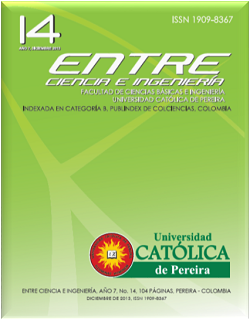Medidas de calidad de voz en una red GSM sobre software libre
Palabras clave:
GSM, USRP, GoS, Dropped Rate, MOSResumen
En este artículo se presentan los resultados obtenidos al medir los parámetros de calidad de una red de telecomunicaciones sobre GSM (Global System Mobile) en la banda DCS-1800 (Digital Cellular Service - 1800MHz); utilizada con el objetivo de articular un sistema de atención de desastres en situaciones de emergencia, empleando un USRP (Universal Software Radio Peripheral) en conjunto con sistema de telefonía IP basado en Asterisk. El USRP se encarga de emular la operación de una BTS (Base Transceiver Station) ejecutando las funciones de un PBX (Private Branch Exchange).
Las mediciones del desempeño de la red se realizaron a partir de tres parámetros probabilísticos: GoS (Grade of service), DCR (Dropped Call Rate) y MOS (Mean Opinion Score).
Con el uso de 8 terminales y escogiendo un GoS del 2% se generó un tráfico de hasta 3,6 Erlang, esta medición se realizó empleando modelos probabilísticos de Erlang B. La cobertura de la red se obtuvo aplicando el modelo Okumura-Hata tanto para interiores como exteriores sin el uso de amplificadores, también se realizaron mediciones del consumo de potencia del sistema.
Referencias
E. Natalizio, V. Loscri, and G. Aloi, “The practical experience of implementing a GSM BTS through Open Software/Hardware,” in Applied Sciences in Biomedical and Communication Technologies (ISABEL), 2010, pp. 1–5.
J. Mpala and G. Van Stam, “Open BTS, a GSM experiment in rural Zambia,” Africomm, Yaounde, Cameroon, pp. 1–9, 2012.
A. Dhananjay and M. Tierney, “WiRE: a new rural connectivity paradigm,” ACM SIGCOMM Computer Communication Review, vol. 41, no. 4, pp. 462–463, 2011.
M. Cabral, I. Almeida, C. Melo, and a. Klautau, “Low-cost GSM telephony in the Amazon region based on open-source / open- hardware projects,” 2009 IEEE Latin-American Conference on Communications, pp. 1–6, Sep. 2009.
I. E. Hashem, A. ElShaarany, A. Y. Abdelbarr, E. S. Hassan, and M. Fikri, “Implementing an Enhanced base station using the software defined radio (CUOPENBTS),” 2012 2nd International Conference on Advances in Computational Tools for Engineering Applications (ACTEA), pp. 39–42, Dec. 2012.
T. Tsou and T. Cooper, “Development of an open-source GSM femtocell and integrated core infrastructure,” in MILITARY COMMUNICATIONS CONFERENCE, 2012, pp. 1–6.
T. A. Cooper, J. H. Reed, and T. C. Clancy, “Integration of OpenSource GSM Networks Integration of Open-Source GSM Networks,” Virginia Polytechnic Institute and Sate University, 2012.
S. Liao and L. Bao, “Implementing a base station using the sdr platform for coexistence of heterogeneous wireless systems,” in SDR Forum Technical Conference and Product Exposition, 2009, no. 0725914, pp. 1–4.
Y. Bai, W. Du, Z. Ma, and C. Shen, “Emergency communication system by heterogeneous wireless networking,” in Wireless Communications, Networking and Information Security (WCNIS), 2010, pp. 488–492.
S. F. Ochoa and R. Santos, “Human-centric wireless sensor networks to improve information availability during urban search and rescue activities,” Information Fusion, pp. 9–11, Jun. 2013.
W. Song, F. Wang, and J. Dai, “A Emergency Communication System based on WMN in underground mine,” 2010 International Conference on Computer Application and System Modeling (ICCASM 2010), no. Iccasm, pp. V4–624–V4–627, Oct. 2010.
Y.-N. Lien, L.-C. Chi, and C.-C. Huang, “A Multi-hop WalkieTalkie-Like Emergency Communication System for Catastrophic Natural Disasters,” 2010 39th International Conference on Parallel Processing Workshops, pp. 527–532, Sep. 2010.
Y.-N. Lien, L.-C. Chi, and Y.-S. Shaw, “A Walkie-Talkie-Like Emergency Communication System for Catastrophic Natural Disasters,” 2009 10th International Symposium on Pervasive Systems, Algorithms, and Networks, pp. 309–314, 2009.
F. Hong, T. Yi, H. Zhao, and B. Xin, “Developing Test System of Ad Hoc Network for Emergency Communications,” 2009 WRI World Congress on Computer Science and Information Engineering, pp. 5–9, 2009.
Z. Shao, Y. Liu, Y. Wu, and L. Shen, “A Rapid and Reliable Disaster Emergency Mobile Communication System via Aerial Ad Hoc BS Networks,” in Wireless Communications, Networking and Mobile Computing (WiCOM), 2011, no. 2007, pp. 1–4.
Y. Gadallah and M. A. Serhani, “A WSN-driven service discovery technique for disaster recovery using mobile ad hoc networks,” 2011 IFIP Wireless Days (WD), pp. 1–5, Oct. 2011.
A. Azad, “Open BTS Implementation with Universal Software Radio Peripheral,” Virginia Polytechnic and State University, 2011.
Gnuradio, “openBTS,” 2013. [Online]. Available: http://gnuradio.org/ redmine/projects/gnuradio/wiki/OpenBTSBackground.
“Ettus Research TM.,” 2013. [Online]. Available: www.ettus.com. [Accessed: 20-Jul-2013].
ETSI (European Telecommunications Standards Institute), “ETSI TCSMG ; ‘GSM Technical Specification. GSM 05.05’ phase 2+ Radio transmission and reception,” Francia, 1996.
Westbay Engeneers, “Telecomunications software and services,” 2013. [Online]. Available: http://www.erlang.com/calculator/erlb/ . [Accessed: 20-Jul-2013].




 <
<


 Revista Entre Ciencia e Ingeniería
Revista Entre Ciencia e Ingeniería .png) entrecei@ucp.edu.co
entrecei@ucp.edu.co.png) ISSN (Impreso) 1909-8367 - ISSN (En Línea) 2539-4169
ISSN (Impreso) 1909-8367 - ISSN (En Línea) 2539-4169 Attribution-NonCommercial 4.0 International (CC By-NC 4.0)
Attribution-NonCommercial 4.0 International (CC By-NC 4.0)
.png) Carrera 21 No. 49-95 Av. de las Américas, Pereira, Risaralda, Colombia
Carrera 21 No. 49-95 Av. de las Américas, Pereira, Risaralda, Colombia